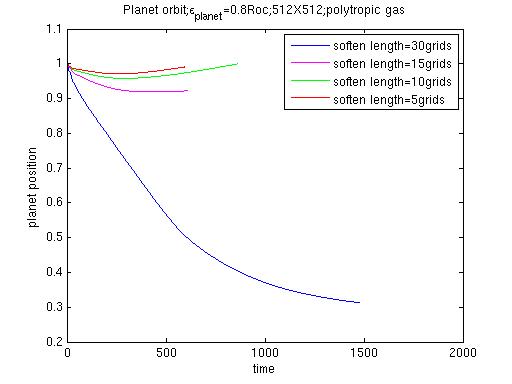|
Home \ Research \ Research Highlights
Research HighlightsMigration of a Jovian Planet In a Self-gravitating Disk of Polytropic Gas
The discovery of "hot Jupiters", which is difficult to understand in the present-day planet formation theory, astrophysicists turned to investigate the migration process of the planet. Most of the studies are limited to disks of isothermal gas without consideration of self-gravity of the disk, in the polar coordinates. Instead, we treat the protoplanetary accretion disk of polytropic gas with self-gravity. Simulations are performed in Cartesian coordinates by using the Antares code, a high-order Godunov code, we have developed. Since we use Cartesian coordinates, there is no need to cut a hole in the center of the disk. On the other hand, we must specify a softening length for the potential of the central star, to avoid the singularity. In the numerical simulations, we study the orbit of the planet as it migrates in resolution 512X512. In the figure we compare our results between different soften lengths. The x-axis of the figure is time(our time unit is 1.9 year) and the y-axis stands distance between the planet and the central star. We find for soften length equals to 30 grids, corresponding to 1.5 AU, the planet in a polytropic gas disk takes little time to migrate to the inner part of the disk. We find negative torque exerted on the planet by the disk material in the Roche's lobe of the planet dominates, the planet loses its angular momentum to gas surrounding it and goes inward. However, for cases with smaller soften length, the planet is unlikely to migrate inwardly. The results of our code are sensitive to soften lengths. |
>> ASIAA



